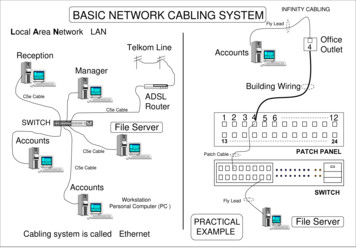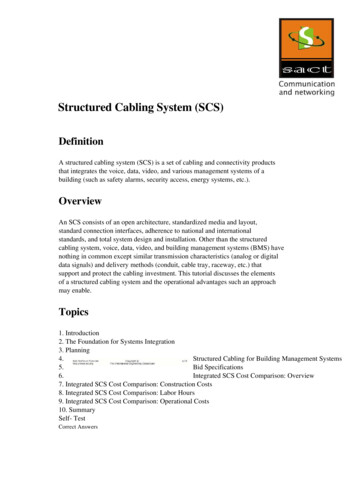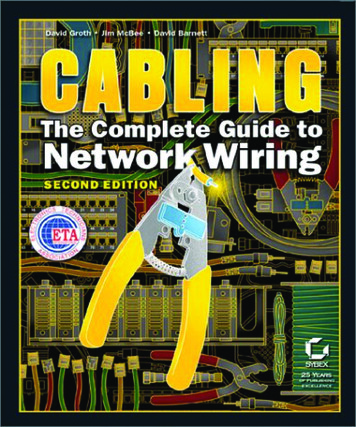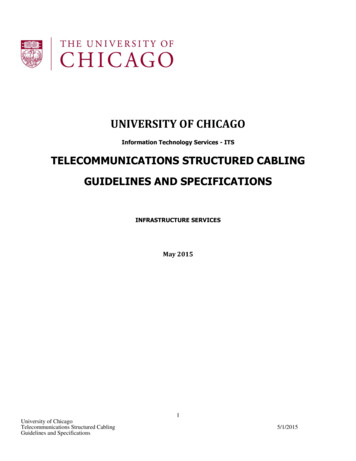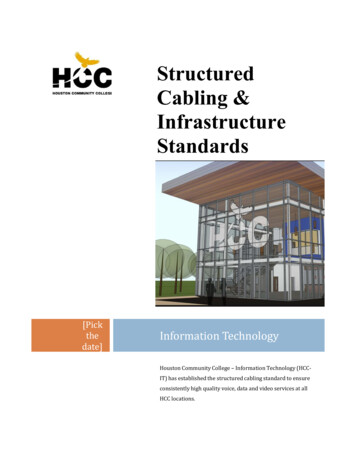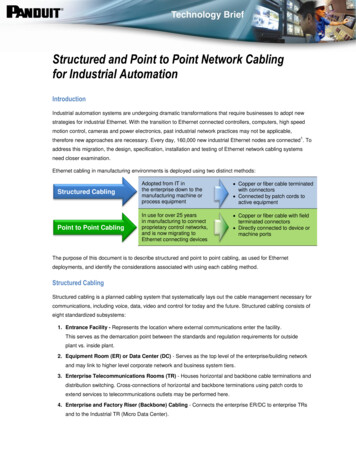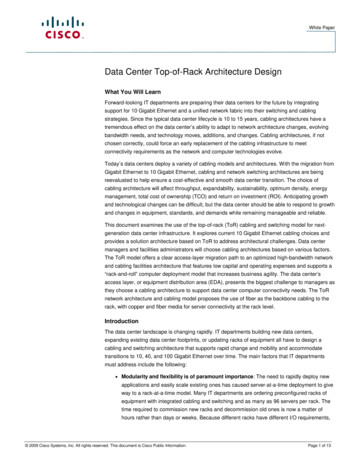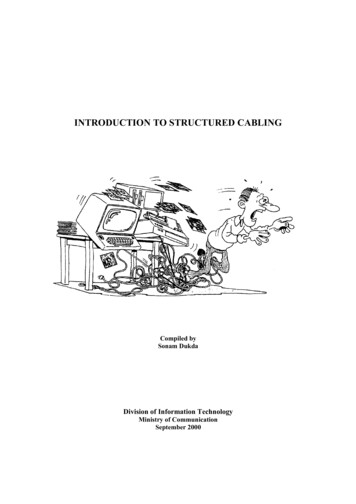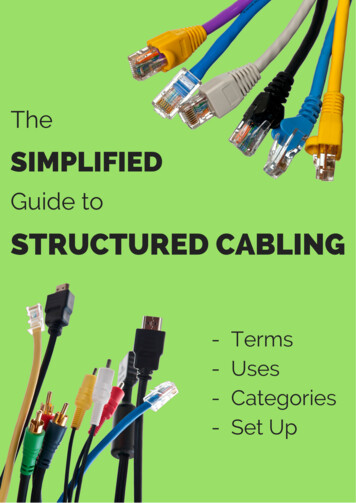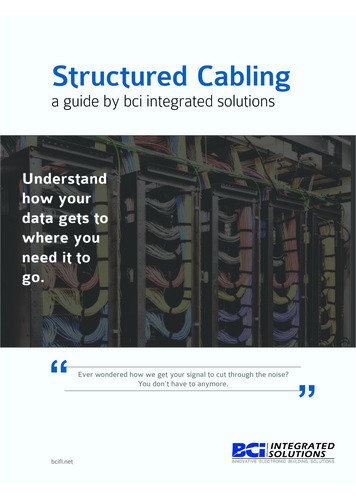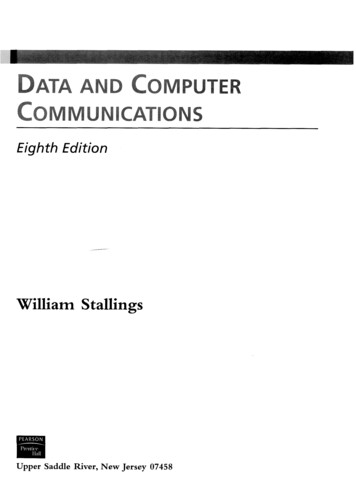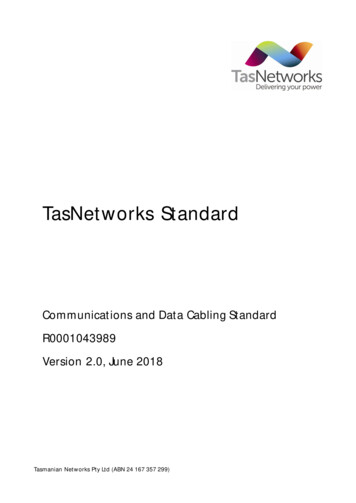
Transcription
TasNetworks StandardCommunications and Data Cabling StandardR0001043989Version 2.0, June 2018Tasmanian Networks Pty Ltd (ABN 24 167 357 299)
TasNetworks Standard - Communications and Data Cabling StandardAuthorisationsActionPrepared byName and titleJohn GangemiSenior Asset Strategy Engineer, Secondary Systems, Asset StrategyAsset Strategy and PerformanceStrategic Asset ManagementReviewed byRobert SmithAuthorised byReview cycleRobert Smith30 litiesThis document is the responsibility of the Asset Strategy and Performance, Tasmanian Networks Pty Ltd, ABN24 167 357 299 (hereafter referred to as "TasNetworks") .Please contact the Asset Strategy and Performance Leader with any queries or suggestions. ImplementationAll TasNetworks staff and contractors. ComplianceAll group managers.Minimum RequirementsThe requirements set out in TasNetworks ’ documents are minimum requirements that must be compliedwith by all TasNetworks team members, contractors, and other consultants.The end user is expected to implement any practices which may not be stated but which can be reasonablyregarded as good practices relevant to the objective of this document. Tasmanian Networks Pty Ltd 2018Page 2 of 32
TasNetworks Standard - Communications and Data Cabling StandardRecord of revisionsSection numberDetailsAllRemoved references to Transend Networks and AuroraAllConverted legacy Transend standard to the TasNetworks’ document templateAll1.61.7.13.14.13.1.14.4Tables, Figures and Equations use the TasNetworks’ document template numberingsystemUpdates references to current Australian Standards, Codes of Practice, and relevantlegislationUpdated Acronyms and Definitions where applicableAdded the requirement of conductive support structures to be equipotentiallybonded as well as earthedAdded the requirement of conductive support structures to be equipotentiallybonded as well as earthedAdded note that cable armour is not to be considered as shielding for EMI and RFIChanged from generic Wireless Access Points/Signals to IEEE 802.11 Wireless AccessPoints/Signals.Page 3 of 32
TasNetworks Standard - Communications and Data Cabling StandardTable of contentsAuthorisations.2Responsibilities. 2Minimum Requirements.2List of tables.6List of figures.71.General81.1.Purpose81.2. Scope81.3.Objective81.4. Precedence81.5.Deviations and/or variations to this Standard91.6. References91.6.1.Legislation91.6.2.TasNetworks’ Standards91.6.3.Australian Standards and Codes of Practice91.6.4. International Standards and Codes of Practice111.7. Acronyms and Definitions121.7.1. Acronyms121.7.2.Definitions131.7.3.Voltage Classifications162. General requirements182.1.Manufacturer’s Instructions18Page 4 of 32
TasNetworks Standard - Communications and Data Cabling Standard2.1.1.Conflicts with this standard182.2. Compliance Labelling182.3.Protection against Damage192.4. Proper Use192.5.Earth Potential Rise (EPR)192.6.Earthing202.7.Low Frequency Induction (LFI)202.8.Network Boundary202.8.1.Cable between Network Boundary and User Device202.9.Users’ Media Converters213.Detailed Requirements for User Communications and Data Cabling in Substations213.1.Cable Support Systems213.1.1.Cable Ducting223.3.Electrical Signals243.3.1. Electrically Conductive Data Cabling243.3.2.Sub-Ducting243.3.3.Earthing of Shielded Cables243.3.4.Terminations on a Krone Frame253.3.5.Terminations on an 8P8C (RJ45) Socket253.4.Optical Signals263.4.1.Fibre Optic Cabling263.4.2.Fibre Optic Cable Terminations27Page 5 of 32
TasNetworks Standard - Communications and Data Cabling Standard3.4.3. Substation LAN Cabling283.4.4.Fibre Optic Patch Panels283.4.5.Fibre Optic Cable Splicing284.Detailed Requirements for TasNetworks’ Telecommunications Network Cabling294.1.Cable Support Systems294.2.Electrical Signals294.2.1.LV Telecommunications Circuits294.2.2. Electrically Conductive Data Cabling294.2.3.Earthing of Shielded Cables304.2.4.Sub-Ducting304.2.5.Terminations on a Krone Frame304.3.Optical Signals304.3.1.Fibre Optic Cabling304.3.2.Fibre Optic Cable Ducting314.3.3.Fibre Optic Cable Terminations314.3.4.Fibre Optic Patch Panels324.3.5.Fibre Optic Cable Splicing334.4.IEEE 802.11 Wireless Signals334.4.1.IEEE 802.11 Wireless Access Points33List of tablesTable 1 - TasNetworks’ Standards.9Page 6 of 32
TasNetworks Standard - Communications and Data Cabling StandardTable 2 - Australian Standards and Codes of Practice. 9Table 3 - International Standards and Codes of Practice.11Table 4 - Types of Cabling.19Table 5 - Example recommended product ranges for fibre optic cablemanagement.23Table 6 - Common communications protocols and their required cablecharacteristic impedances.24Table 7 - TIA-EIA 568B 8P8C termination colour code. 25Table 8 - An example of fibre optic colour coding for a 12-core fibreseparated into three buffer tubes.27Table 9 - Some Recommended Electrical Telecommunications Cables.29Table 10 - Example components for Rittal cabinet fibre management. 32List of figuresFigure 1 - Voltage classifications used in this standard. 18Figure 2 - Ideal user media converter cabinet location.21Figure 3 - Example of intended cable ducting in protection and controlcabinets.23Figure 4 - Correct earthing of electrically conductive twisted pair cablingbetween equipment and a Krone frame.25Figure 5 - ST Connector and feed-through. 28Figure 6 - LC Connectors (left: simplex, centre: duplex) and feed-through.28Figure 7 - Correct earthing of electrically conductive twisted pair cablingbetween equipment and a Krone frame.30Figure 8 - SC/APC Connector and feed-through.32Figure 9 - LC Connectors (left: simplex, centre: duplex) and feed-through.32Page 7 of 32
TasNetworks Standard - Communications and Data Cabling Standard1 General1.1 PurposeThe purpose of this document is to define the requirements, specifications and application of allcommunications cabling and terminations to be installed on substation and telecommunications networksites owned and operated by, or under the responsibility of, Tasmanian Networks Pty Ltd (hereafter referredto as “TasNetworks”). This includes cabling used for communications to protection and control devices, datacabling and cabling used within the TasNetworks’ telecommunications network.1.2 ScopeThis standard applies to all communications cabling carried out by TasNetworks’ employees, contractors, orany other person or entity providing cabling in substations or telecommunications facilities underTasNetworks’ responsibility.1.3 ObjectiveThe basic objectives of this standard are to: Protect the health and safety of any person who may operate; work on; use services supplied bymeans of; or be otherwise reasonably likely to be affected by the operation of; atelecommunications network, telecommunications facility, telecommunications facility, substation,asset or sites that are owned and operated by, or are under the responsibility of, TasNetworks;Protect the integrity and proper functioning of a telecommunications network, telecommunicationsfacility, substation, asset or sites that are owned and operated by, or are under the responsibility of,TasNetworks; andTo ensure that where practical a standard approach and philosophy is used to design, operate andmaintain assets and sites that are owned and operated by, or are under the responsibility ofTasNetworks.1.1 PrecedenceAny apparent conflict between the requirements of this standard and the law, mandatory requirements,industry standards, project specifications, non-statutory standards or guidelines, and any other associateddocuments should be brought to the immediate attention of TasNetworks’ for resolution. No action must betaken that might result in a breach of law or mandatory standard.Where there may be a conflict between the requirements of this standard and any: law, mandatory requirement, or industry standard, then: that law or statutory requirement willprevail over this standard; andnon-mandatory standard or guideline, then: this standard will prevail over that standard orguideline; orproject specification, then the contract documentation will prevail over this standard.If other TasNetworks’ cabling standards conflict with this telecommunications standard such as theTasNetworks’ power cabling standards, this standard shall take precedence.Page 8 of 32
TasNetworks Standard - Communications and Data Cabling Standard1.1 Deviations and/or variations to this StandardApproval for a deviation to this standard may only be accorded if it does not reduce the quality ofworkmanship, pose a safety risk to personnel or equipment, and does not deviate from the intent of thisstandard. Deviations, if any, must be specifically requested and approved in writing by TasNetworks’ AssetStrategy and Performance team leader.1.2 ReferencesAs a component of the complete specification for a system, this standard is to be read in conjunction withother standards and documents as applicable. In particular, this includes the documents mentioned below.1.2.1 LegislationParliament of Australia, Telecommunications Act 1997Parliament of Australia, Radiocommunications Act 19921.2.2 TasNetworks ’ StandardsTable 1 - TasNetworks’ StandardsRecord 65984R0000522693TasNetworks’ StandardDistribution Standard - Cables and ConductorsEHV Cable System StandardFibre Optic Overhead Ground Wire (OPGW) StandardTasNetworks Nomenclature StandardHV and LV Cable Systems StandardSubstation Lightning Protection and Earthing StandardTransmission Line and Cable Name and Number StandardSite Names and Abbreviations StandardAC Distribution System StandardDC Distribution System Standard1.2.3 Australian Standards and Codes of PracticeTable 2 - Australian Standards and Codes of PracticeRecord NumberACMA Labelling NoticesDocument NameThe Telecommunications (LabellingNotice for Customer Equipment andCustomer Cabling) InstrumentPage 9 of 32OrganisationAustralian Governmentunder theTelecommunicationsAct 1997DatePublished2015
TasNetworks Standard - Communications and Data Cabling StandardRecord NumberDocument NameOrganisationDatePublishedRadiocommunications (ComplianceLabelling – Devices) NoticeAustralian Governmentunder theTelecommunicationsAct 1997RadiocommunicationsAct 19922014Radiocommunications Labelling(Electromagnetic Compatibility)NoticeAustralian Governmentunder theTelecommunicationsAct 1997RadiocommunicationsAct 19922017ACMA Labelling NoticesRadiocommunications (ComplianceLabelling - Electromagnetic Radiation)NoticeAustralian Governmentunder theTelecommunicationsAct 1997RadiocommunicationsAct 19922014AS 2067:2016Substations and high voltageinstallations exceeding 1 kV a.c.Standards Australia2016AS/CA S008:2010Requirements for customer cablingproductsCommunicationsAlliance Ltd2010AS/CA S009:2013Installation requirements forcustomer cabling (Wiring rules)CommunicationsAlliance Ltd2013AS/NZS 1367:2016Coaxial cable and optical fibresystems for the RF distribution ofdigital television, radio and in-houseanalog television signals in single andmultiple dwelling installationsStandards Australia2016AS/NZS 2967:2014Optical fibre communication cablingsystems safetyStandards Australia2014AS/NZS 3000Australian/New Zealand Wiring RulesStandards Australia2018AS/NZS 3015(obsolescent notwithdrawn)Extra-Low Voltage DC Power Suppliesand Service Earthing Within PublicTelecommunications NetworksStandards Australia2004AS/NZS 3080:2013Information technology—Genericcabling for customer premises(ISO/IEC 11801:2011, MOD)Standards Australia2013AS/NZS 3835.1Earth Potential Rise – Protection ofTelecommunications Network Users,Personnel and Plant; Part 1: Code ofPracticeStandards Australia2006ACMA Labelling NoticesACMA Labelling NoticesPage 10 of 32
TasNetworks Standard - Communications and Data Cabling StandardRecord NumberDocument NameOrganisationDatePublishedAS/NZS 3835.2Earth Potential Rise – Protection ofTelecommunications Network Users,Personnel and Plant; Part 2:Application GuideStandards Australia2006AS/NZS 60950.1:2015Information technology equipment Safety - Part 1: General requirements(IEC 60950-1, Ed. 2.2 (2013), MOD)Standards Australia2015AS/NZS IEC60825.1:2014Safety of laser products Part 1:Equipment classification andrequirementsStandards Australia2014AS/NZS IEC60825.2:2011Safety of laser products Part 2: Safetyof optical fibre communicationsystems (OFCS)Standards Australia2011AS/NZS ISO/IEC24702:2007Telecommunications installations —Generic cabling — Industrial premisesStandards Australia2007AS/NZS ISO/IEC24764:2012Generic cabling systems for datacentresStandards Australia2012CA C524:2013External Telecommunication CableNetworks Industry CodeCommunicationsAlliance Ltd2013HB 101-1997 (CJC 5)Coordination of power andtelecommunications - Low FrequencyInduction (LFI): Code of practice forthe mitigation of hazardous voltagesinduced into telecommunicationslinesStandards Australia1997HB 101-1997 (CJC 5)Amdt 1-1998Coordination of power andtelecommunications - Low FrequencyInduction (LFI): Code of practice forthe mitigation of hazardous voltagesinduced into telecommunicationslinesStandards Australia19981.2.4 International Standards and Codes of PracticeTable 3 - International Standards and Codes of PracticeRecord NumberANSI/TIA 598-CANSI/EIA 359-ATIA/EIA 568BDocument NameOptical Fiber Cable Color CodingColors for Color Identification and CodingTermination of an 8P8C PlugPage 11 of 32OrganisationANSI/TIAANSI/EIATIA/EIA
TasNetworks Standard - Communications and Data Cabling Standard1.3Acronyms and Definitions1.3.1 Acronyms8P8C8 Position 8 Contact (commonly known as RJ45)AC (or “ac”)Alternating Current (defined as the root mean square value unless stated otherwise)ACMAAustralian Communications and Media AuthorityADSSAll-Dielectric, Self-Supporting (referring to fibre optic cables)ASAustralian StandardAWGAmerican Wire GaugeBERTBit Error Rate TestCACommunications AllianceCAECustomer Access EquipmentCESCommunications Earth SystemCETCommunications Earth TerminaldBDecibelsDC (or “dc”)Direct CurrentDDFData Distribution FrameEHVExtra-High VoltageELVExtra-Low VoltageEMIElectromagnetic InterferenceEPREarth Potential RiseEWISEmergency Warning and Intercommunication SystemFOBOTFibre Optic Break Out TrayHVHigh VoltageIEDIntelligent Electronic DeviceISOInternational Organisation for StandardisationITU-TInternational Telecommunication Union – Telecommunications Standardisation SectorLANLocal Area NetworkLCLittle Connector (sometimes Lucent Connector)LFILow Frequency InductionLVLow VoltageMDFMain Distribution FrameMIMSMineral Insulated Metal SheathMIPPModular Industrial Patch PanelNTDNetwork Termination DeviceOPGWOptical Ground-WireOPUCOptical Underground CablePage 12 of 32
TasNetworks Standard - Communications and Data Cabling StandardPABXPrivate Automatic Branch ExchangePoEPower over EthernetRFIRadiofrequency InterferenceRJ45Registered Jack 45RMSRoot Mean SquareRTURemote Terminal UnitSC/APCSquare Connector / Angled Physical ConnectionSELVSafety Extra-Low VoltageSFPSmall Form-factor PluggableSTStab-TwistSWASteel Wire ArmouringSWERSingle Wire Earth ReturnTNVTelecommunications Network VoltageTOTelecommunications OutletTRCTelecommunications Reference ConductorUVUltraviolet (radiation/light), e.g. direct sunlightWANWide Area Network1.3.2 DefinitionsThe majority of the following definitions are taken from AS/CA S009 where relevant in order to minimisecross referencing.1.3.2.1 CablingCable or cables and any associated works or parts, e.g. pits, poles, conduits, trays, connecting devices,jumpers, etc.1.3.2.2 Cabling providerA person who performs or supervises cabling work.1.3.2.3 Communications Earth System (CES)A system of earthing using common elements to provide for earthing of electrical and communicationsequipment within a premise.Note: A CES may be used for protective and functional earthing for telecommunications purposes1.3.2.4 Communications Earth Terminal (CET)A terminal provided for the purpose of equipotential bonding of the CES or the TRC to the main earthing bar,main earthing conduit, or sub-main earthing conductor of the electrical installation.Note: the CET provides a demarcation between the electrical earthing system and the telecommunicationsearthing system and was formerly known as a “bonding terminal”.Page 13 of 32
TasNetworks Standard - Communications and Data Cabling Standard1.3.2.5 Cross-connectionA method of providing for flexible interconnection of cables or cable elements, by means of jumpers or patchcords.1.3.2.6 CustomerA legal person, including a natural person, a corporation or an organisation, that subscribes to (pays for) thesupply of a carriage service.Note: for most purposes of this standard, TasNetworks’ Protection and Control can be considered as acustomer of the TasNetworks’ Telecommunications Operations team.1.3.2.7 Customer access equipment (CAE)Customer equipment with multiple ports (local or network) that provides access (gateway functions) to atelecommunications network and is capable of switching, storage, processing, conversion, integration, lineisolation/coupling or multiplexing of analogue or digital voice or voice equivalent communication.Note 1: examples of CAE include, but are not limited to, PABX or key systems, line isolators, ISDN terminaladapters, echo cancellers, interactive voice response systems, voice/packet gateway, integrated accessdevices, voice messaging systems, protection relays and remote terminal units (RTUs).Note 2: CAE is a type of customer equipment but, for the purposes of this standard, is not considered to be“terminal equipment”. An operator console, telephone handset or any other peripheral device connected toCAE that may be regularly handled by an end-user is “terminal equipment”.Note 3: CAE was formerly referred to as CSS (Customer Switching System)1.3.2.8 Customer cabling and equipmentAny line (cabling) or equipment, apparatus, tower, mast, antenna, or other structure, or system (softwarebased or otherwise) that is used, installed ready for use, or intended for use on the customer side of theboundary of a telecommunications network.1.3.2.9 DistributorA collection of components used to terminate cables which provides for cross-connection of cables or cableelements, e.g. a fibre-optic patch panel or a Krone frame.Note: Any cable termination equipment used to connect two or more cables or cable elements togetherwithout cross-connection (e.g. a cable joint) is not regarded as a distributor for the purposes of thisstandard.1.3.2.10 Earth Potential Rise (EPR)A rise in voltage of an earthing system and the surrounding soil with respect to a distant earth. EPR is causedprimarily when an earth fault on an HV or EHV power system produces a current flow through the earthingsystem of an HV or EHV site.1.3.2.11 End-userThe customer or any other person that may use a carriage service, e.g. an employee of the customer.1.3.2.12 Extra-High Voltage (EHV)Refer to section 1.7.3: Voltage Classifications.Page 14 of 32
TasNetworks Standard - Communications and Data Cabling Standard1.3.2.13 Extra-Low Voltage (ELV)Refer to section 1.7.3: Voltage Classifications.1.3.2.14 Functional earthThe earthing of a point in equipment or in a system which is necessary for a purpose other than safety, e.g.as a reference voltage for a telecommunications circuit.1.3.2.15 High Voltage (HV)Refer to section 1.7.3: Voltage Classifications.1.3.2.16 Indoor cablingCustomer cabling that is installed inside a building but not underground or exposed to the elements.Note: cabling installed within a sheltered structure between buildings such as a service tunnel, coveredwalkway or above-ground trunking system, is treated as indoor cabling for certain requirements of thisstandard (e.g. cable properties and separation from other services).1.3.2.17 Isolation deviceA device that isolates each of the conductors of a telecommunications service to prevent the transfer ofhazardous voltages but allows the service to operate normally. For example an optical isolator.1.3.2.18 JumperA cable unit or cable element without connectors, typically one to four twisted pairs, either unsheathed orsheathed, used to make a cross-connection within a distributor.1.3.2.19 Low Frequency Induction (LFI)The generation of currents in a telecommunications line due to inductive coupling with a power line carryinglarge unbalanced currents e.g. during a fault condition on the HV or EHV power system.1.3.2.20 Low Voltage (LV)Refer to section 1.7.3: Voltage Classifications.1.3.2.21 Main distribution frame (MDF)A distributor that provides, or is intended to provide, an electrical termination point for a communicationsservice provider’s twisted pair lead-in cabling.Note: for the purpose of this standard, the TasNetworks’ Telecommunications Operations team can beconsidered as a communication service provider providing services to customers including TasNetworks’Protection and Control amongst others.1.3.2.22 Network boundaryRefer to Section 2.8: Network Boundary.1.3.2.23 Outdoor cablingCustomer cabling that is installed external to a building, either underground or exposed to the elements.Note: cabling installed within a sheltered structure between buildings such as a service tunnel, coveredwalkway or above-ground trunking system, is treated as indoor cabling for certain requirements of thisstandard (e.g. separation from other services).Page 15 of 32
TasNetworks Standard - Communications and Data Cabling Standard1.3.2.24 Patch panelA distributor (see section 1.7.2.9) designed to accommodate the use of patch cords.1.3.2.25 Protective earthThe earthing of a point in equipment or in a system which is necessary for safety purposes.1.3.2.26 Sub-ductA conduit installed within a larger conduit, duct, or trunking.Note: sub-ducting is used to provide physical or electrical separation between a cable installed within thesub-duct and any
AS/NZS 3000 Australian/New Zealand Wiring Rules Standards Australia 2018 AS/NZS 3015 (obsolescent not withdrawn) Extra-Low Voltage DC Power Supplies and Service Earthing Within Public Telecommunications Networks Standards Australia 2004
